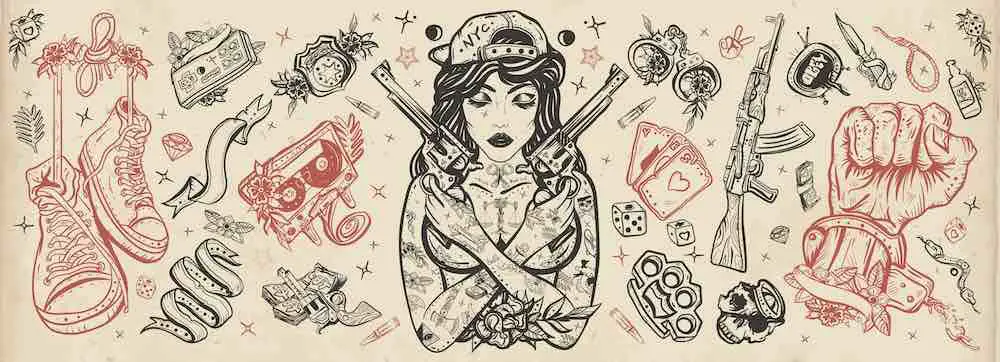Classic tattoo styles have a rich history and continue to influence the world of body art today. With their bold outlines, vibrant colors, and iconic imagery, these timeless designs hold a special place in the hearts of tattoo enthusiasts and artists alike. Classic styles have evolved to cater to various tastes and preferences, but their roots lie in traditional American tattooing, which is often associated with sailors and the nautical world.

These old-school tattoos encompass a wide range of subject matter, including fierce predatory animals, nautical symbols, pinup girls, and floral designs. The classic tattoo palette features bold, saturated colors that achieve a striking and visually impactful result. Additionally, the shading techniques used in these designs give them depth and dimension, ensuring that they stand out and make a statement.
Key Takeaways
- Classic tattoo styles are iconic, with roots in traditional American tattooing.
- Bold outlines, vibrant colors, and varied imagery characterize these designs.
- Shading techniques and dynamic subject matter make classic tattoos enduringly popular.
Classic Tattoo Styles
Old School Tattoo Style
The Old School Tattoo Style, also known as American Traditional or Classic Americana, is characterized by its bold outlines, limited color palette, and iconic designs. Common imagery in this style includes roses, panthers, tigers, flowers, women’s faces, pin-up girls, and sailboats. This style often features themes and symbols related to luck and milestones, with many designs originating from the sailor cultures of the early 20th century.
Japanese Tattoo Style
Japanese Tattoo Style encompasses a broad range of designs drawing inspiration from Japanese art, culture, and history. This style is often recognized by its large-scale, intricate designs that often cover entire body sections such as the arm, leg, or back. Traditional Japanese tattoos typically feature themes such as folklore, mythical creatures, and nature-inspired imagery. Common subjects in Japanese tattoo style include koi fish, dragons, samurais, geishas, and cherry blossoms. The bold lines and subtle shading techniques employed in Japanese tattoos create a sense of depth and realism.
Blackwork Tattoo Style
Blackwork Tattoo Style is characterized by the use of bold, black ink to create intricate designs and patterns, often inspired by tribal or ancient art. This style can vary greatly in terms of complexity and subject matter, with some blackwork tattoos featuring simple geometric shapes and linework, while others incorporate more detailed imagery such as animals, nature, or religious symbols. Blackwork tattoos often rely on the contrast between solid black areas and negative space to create striking visual effects.
Tribal Tattoo Style
Tribal Tattoo Style is an ancient art form that features bold black lines and abstract patterns, often inspired by various indigenous cultures around the world. This style is characterized by its use of curves, shapes, and repetitive designs, which typically hold cultural or spiritual significance. Many tribal tattoos draw inspiration from Polynesian, Native American, and African cultures, showcasing intricate patterns and symbolism unique to these communities. Tribal tattoos have seen a surge in popularity in recent years, with many artists blending traditional tribal elements with modern tattooing techniques.
Influential Tattoo Artists
Sailor Jerry (born Norman Collins) is a prominent figure in the history of classic tattoo styles, particularly American Traditional. He was active during the mid-20th century and heavily influenced by his time in the U.S. Navy. Sailor Jerry’s art was characterized by bold lines, vibrant colors, and iconic imagery such as anchors, swallows, nautical stars, and pinup girls. His distinct style helped solidify the identity of American Traditional tattoos and remains influential today.
Another notable artist in the realm of classic tattoo styles is Bert Grimm. With a career spanning over 70 years, Grimm is often considered a pioneer of traditional tattooing. He contributed significantly to the development of the art form, incorporating elements like hearts, daggers, and roses into his work. Bert Grimm’s skill and innovation earned him the nickname “The Tattooer’s Tattooer,” and his designs continue to inspire many modern tattoo artists.
Ed Hardy is yet another key figure in the world of tattoos. Although Hardy’s work covers a range of styles, he is well-known for his contributions to American Traditional tattoo art. He trained under Bert Grimm and Sailor Jerry, incorporating their iconic imagery and design elements into his own unique style. Ed Hardy’s name is now synonymous with both tattooing and the fashion industry, as his designs have been adapted for clothing and accessories.
These influential tattoo artists helped shape the classic tattoo styles we know today. Their innovative techniques, bold designs, and distinctive imagery combined to create a timeless aesthetic that continues to inspire and captivate both tattoo enthusiasts and artists alike.
Key Features of Classic Tattoo Styles
Classic tattoo styles, also known as Old School or American Traditional, are characterized by their distinct look and iconic imagery. When thinking of classic tattoos, familiar objects like roses, anchors, and swallows often come to mind. These designs trace their roots back to the early 20th century and hold a special place within the tattoo community. Below are some key features of classic tattoo styles.
One of the most recognizable aspects of classic tattoo styles is the use of bold lines. These thick outlines create striking images that stand the test of time. The bold lines not only provide a solid foundation for the design but also help the tattoo age well.
The color palette for classic tattoo styles is generally limited, with red and black being the most dominant colors. These limited colors create a simple yet vibrant look that is both captivating and timeless. In some cases, other colors may be used sparingly, but they never take away from the prominence of red and black in the design.
The imagery in classic tattoo styles revolves around a select few themes, often inspired by sailors and nautical imagery. Some of these common objects include anchors, roses, swallows, and sailboats. These iconic designs often represent milestones, good luck, or serve as symbols of protection for sailors. Additionally, other recognizable images often seen in this style include flowers, tigers, panthers, women’s faces, and pin-up girls.
In classic tattoo styles, geometric shapes are usually not a focus. Instead, the designs emphasize iconic imagery and bold lines that tell a story or convey a message. This focus on meaningful and easily recognizable objects gives classic tattoos their timeless appeal.
New School Tattoo Styles
New School Tattoo style emerged as a popular trend in the 1990s and continues to be a significant style in the tattoo industry today. It is characterized by its exaggerated features, bright colors, and often references pop culture subject matter. The style combines various elements from other tattoo styles like realism, neo-traditional, and watercolor to create a unique and appealing presentation.
In contrast to old school tattoos, which mainly use bold outlines and limited color palettes, new school tattoo designs often incorporate vibrant and varied colors. Artists utilize bold black lines and large shapes to help colors stand out and make the tattoos legible from a distance. This blend of different tattooing techniques creates visually engaging pieces that attract attention and make a statement.
One key aspect of this style is the incorporation of aspects from art styles like art nouveau and art deco. Through the use of highly stylized, modernized imagery, and dynamic composition, new school tattoos stand out as a bold expression of individual creativity. Some artists take inspiration from geometric tattoo styles and blend them with more abstract elements to form unique designs.
The realism tattoo style also has a notable influence on new school pieces. Highly detailed and accurate representations of subject matter, such as portraits or animals, are often combined with new school elements to create a refreshing, innovative approach to tattooing.
Popular Icons and Meanings
Classic tattoo styles encompass a variety of designs and symbols, each with their own unique meanings and history. Some of the most recognizable and popular icons in this category include dragons, latin phrases, and old school American traditional tattoos.
Dragons have been a staple in tattoo designs for centuries, particularly in the Western and Japanese Irezumi styles. They symbolize power, strength, and wisdom. These mythical creatures often have intricate appearances, showcasing their unique traits and abilities. In both Western and Irezumi styles, dragons are believed to protect and guide those who carry their image.
Latin phrases hold significant meaning in various tattoo designs, often representing strength, freedom, and life philosophies. The use of these phrases in classic tattoo styles demonstrates the timeless nature of wisdom and personal growth. The combination of Latin text and traditional imagery serves as a powerful and symbolic representation of personal beliefs and values.
Old school tattoos and American traditional tattoos share common themes and appearances, with bold lines, bright colors, and easily identifiable imagery. Nautical designs are prevalent in these tattoo styles, featuring anchors, swallows, and ships. Polynesia, the origin of traditional American tattoo art, also plays a significant role in shaping the overall aesthetic.
Patriotic symbols, such as flags, military emblems, and bald eagles, are frequently utilized, representing love and pride for one’s country. Lucky icons, like horseshoes, dice, and four-leaf clovers, also appear commonly in classic tattoo styles as symbols of luck, fortune, and superstition.
Color and Shading Techniques
When creating tattoos in a classic style, artists typically use a variety of colors and shading techniques to bring their designs to life. The ink used for these tattoos, particularly black ink, is crucial for establishing the foundation of the art.
A popular tattoo style that highlights the use of ink is the black and grey tattoo style. As the name implies, this style is predominantly composed of varying shades of black and grey. The gradient effect achieved in this style is accomplished by diluting the black ink with a solution, resulting in different tones.
In addition to black and grey, classic tattoo styles often utilize bold colors such as yellow and green. These vibrant tones are frequently seen in nautical imagery, which is a staple of traditional tattoo designs. It’s common to see designs featuring anchors, ships, and other sea-related symbols incorporating the striking contrast of yellow and green.
Shading plays a vital role in giving depth to tattoo designs. Artists use several shading techniques to create dimension and texture in their artwork. One of those methods is whip shading, which involves dragging the needle across the skin and flicking the machine away from the skin at the end of each stroke. This movement results in a stroke that starts dark and moves to a lighter gradient, adding depth to the design.
In addition to whip shading, some artists may employ brush shading for certain tattoo styles like portraits. The technique requires a long taper needle and involves moving it back and forth like a pendulum, applying ink at an angle to create a blending effect.
Another important aspect of classic tattoo designs is the presence of predatory animals. These can be depicted in various colors, often with a focus on black and grey shading. The bold use of color and shading techniques in such motifs helps to create a sense of movement and a sense of strength.
Innovations in Tattoo Design
Over the years, tattoo design has evolved dramatically, integrating elements from various cultures, art movements, and animal symbolism. One classic tattoo style that has consistently been popular is the traditional American style, often associated with nautical imagery, pinup female figures, and animals like panthers and tigers. Bold outlines and a limited color palette define this iconic style.
Japanese tattoo art, another classic style, has a rich history. Originating from Japan, this tattoo style is distinguished by its delicate brushstrokes, intricate patterns, and mythical animals. Masterpieces of this style convey values and personality through imagery, such as koi fish representing perseverance and dragons symbolizing strength.
The incorporation of surrealism in tattooing has elevated the art form to new heights. This modern movement takes inspiration from classic tattoo styles, adding a twist with imaginative elements and contemporary techniques. Animal motifs remain popular, often being manipulated or combined with other objects to create unique designs.
In both the American and Japanese tattoo styles, values and personal characteristics can be expressed through the choice of animals. For example, a tiger might signify fierceness, a lion could symbolize power, and a koi fish might represent resilience. These iconic animals not only carry cultural significance, but also allow individuals to communicate their personality through body art.
Tattoo Culture and Influence
Tattoo culture has evolved over the years, with various styles and influences shaping the art form. One popular style is Western traditional tattooing, characterized by its bold outlines and similar colors and imagery. Classic Americana tattoos, for example, often feature iconic designs such as anchors, roses, and eagles.
Samurai imagery is another significant influence in the world of tattooing. This Japanese style, known for its intricate scenery and portraiture, showcases the rich culture and history of the samurai warrior class. Artists who specialize in this style typically use finely detailed lines and shading to bring these scenes and characters to life.
In contrast to the bold, intricate designs of traditional styles, stick and poke tattoos offer a simpler aesthetic. These tattoos, often done by hand, consist of small, solid shapes and lines created by poking the skin with a needle and ink. Although they may be less intricate than other styles, stick and poke tattoos have a unique charm and offer a more personal touch.
Realistic trash polka is an innovative tattoo style emerging from the contemporary scene. This style combines realistic imagery with abstract elements to create a collage-like structure. It often incorporates printed materials, such as newspaper clippings or photographs, into the design, resulting in tattoos that blend visual textures and striking contrasts.
One unifying factor among the various styles and influences in tattooing is the use of ink on the human canvas. Whether applied through a traditional tattoo machine or by hand, ink is the medium through which tattoo artists transform their subjects’ skin into masterpieces.
Frequently Asked Questions
What is the origin of classic tattoos?
Classic tattoos, also known as American traditional tattoos, can be traced back to the late 19th century and the early 20th century. Sailor Jerry Collins, an American tattoo artist, played a significant role in popularizing this style. The classic tattoo style is closely tied to nautical imagery, as well as various symbols influenced by the cultural interests and innovations of the time.
What are the key design elements in classic American traditional tattoos?
Classic American traditional tattoos primarily feature bold outlines and the use of similar colors like red, green, and yellow. The designs often include nautical imagery, pinup female figures, fierce predatory animals, hearts, roses, and daggers. Traditional tattooing requires clean, bold black outlines and the use of solid pigment to create strong, eye-catching designs.
How do classic tattoos differ from neo-traditional?
Neo-traditional tattoos evolved from the classic tattoo style, featuring an updated and modern twist. While both styles share bold outlines and similar imagery, neo-traditional tattoos often incorporate a wider range of colors, shading, and intricate details. These tattoos also expand beyond the traditional nautical and Americana themes, allowing for more diverse subject matter.
What are some iconic classic tattoo imagery?
Classic tattoo imagery often includes nautical elements such as anchors, ships, and sailor knots. Additionally, pinup girls, hearts, roses, daggers, and predatory animals like panthers, snakes, and eagles are common features in this style. Iconic symbols such as the “Mom” heart and swallows, which represent a sailor’s safe return home, are also classic tattoo staples.
How has the classic tattoo style evolved over time?
While the core elements of the classic tattoo style have remained relatively consistent, it has evolved over time to include new imagery, aesthetics, and artist interpretations. Today, classic tattoos can be seen accommodating modern themes, such as pop culture references, while still maintaining their traditional roots. There has also been a resurgence in the popularity of this style in recent years, as people are drawn to its vintage charm and bold, recognizable designs.
What makes a tattoo artist skilled in classic styles?
A skilled classic tattoo artist should have a deep understanding of the essential design elements, color palette, and techniques that define the classic style. They should be adept at creating bold, clean outlines, using solid pigment, and incorporating traditional imagery. Additionally, the artist should have a strong sense of composition and balance, as well as an ability to adapt designs to suit individual client tastes and preferences.


